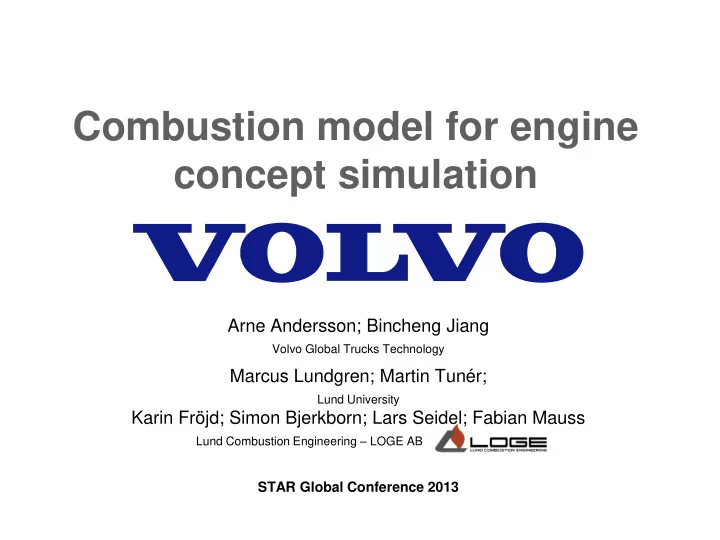

Combustion model for engine concept simulation Arne Andersson; Bincheng Jiang Volvo Global Trucks Technology Marcus Lundgren; Martin Tunér; Lund University Karin Fröjd; Simon Bjerkborn; Lars Seidel; Fabian Mauss Lund Combustion Engineering – LOGE AB STAR Global Conference 2013
Combustion model needed for advanced combustion in engine concept development Systems approach is needed Integration with GT-Power Global Trucks Technology Arne Andersson, STAR Global Conference 2013
PPC is challenging to model A wide span of combustion modes in a load sweep IMEP 8 bar Like HCCI IMEP 12 bar PPC IMEP 26 bar Diffusion combustion Global Trucks Technology Arne Andersson, STAR Global Conference 2013
Model: 3D – 1D simulation chain OPTIMIZED Engine setup PROCESS DESIGN Mixing time ( t , x ) CHEMISTRY STAR-CD DARS – GT-Power RESULTS DARS SRM + GT-Power Global Trucks Technology Arne Andersson, STAR Global Conference 2013
The Stochastic Reactor Model (SRM) The particle properties (Temperature/enthalpy, species concentration) are In the zero-dimensional Stochastic Reactor Model, the in-cylinder gas mass statistically described by a Probability Density Function (PDF). is discretized into a set of particles without any spatial resolution. The development of the PDF is calculated through particle interaction (mixing) Each individual particle is treated as a well-stirred reactor. and detailed chemistry. Global Trucks Technology Arne Andersson, STAR Global Conference 2013
The Stochastic Reactor Model (SRM) Mixing is modeled as a stochastic process: Particles are randomly selected to interact with each other. Both temperature and chemical composition is exchanged. The frequency of mixing events is determined by the turbulent mixing time τ Global Trucks Technology Arne Andersson, STAR Global Conference 2013
Chemistry The SRM model makes use of detailed chemistry. Three different mechanisms were evaluated: 33-species Tsurushima mechanism 200-species NICE mechanism 477-species Toluene Reference Fuel (TRF) mechanism The 33-species mechanism was found to yield unrealistic ignition timing, whereas the differences between the 200- species mechanism and the 477-species mechanism were negligible. The 200-species NICE mechanism has been used for all simulations in this presentation. Global Trucks Technology Arne Andersson, STAR Global Conference 2013
Fuel injection Vaporized fuel is introduced as new particles in the SRM. These particles are mixed with the background gas (air and EGR) according to the turbulent mixing time. Global Trucks Technology Arne Andersson, STAR Global Conference 2013
Example: Vaporized cold fuel mixing with background gas and igniting Ф T lg(X i ) Ф T lg(X i ) Global Trucks Technology Arne Andersson, STAR Global Conference 2013
PPC modeling with the SRM Problem: While the SRM model presumes statistical homogeneity in the combustion chamber, this assumption is not true for the PPC. At the point of ignition, much fuel is still concentrated in a rich zone Solution: Divide the background gas in the SRM into two distinct zones. Let the injected fuel be introduced into one of the zones. Mix predominantly within each zone to capture the effects of stratification. Global Trucks Technology Arne Andersson, STAR Global Conference 2013
PPC modeling with the SRM With the two-zone approach, each property of the gas is described by two superimposed PDF:s. The zone mass evolution as function of time is a user input. Global Trucks Technology Arne Andersson, STAR Global Conference 2013
Model setup: Zone size definition The SRM zone mass evolution is calculated from the mixture fraction PDF predicted by STAR-CD – Mass of fuel rich zone = sum of mass in CFD cells where Z > 0.02 Zone size comparison, SRM CFD data, IMEP 12 bar Global Trucks Technology Arne Andersson, STAR Global Conference 2013
Model setup: Mixing time and other data The mixing time conditioned at stoichiometry is extracted from the STAR-CD simulation and used in the model. All other relevant parameters were kept constant between the cases. No further tuning applied. Global Trucks Technology Arne Andersson, STAR Global Conference 2013
Case 2 – IMEP 8 bar Time of ignition well predicted. HCCI type combustion Global Trucks Technology Arne Andersson, STAR Global Conference 2013
Case 1 – IMEP 12 bar Time of ignition well predicted. A small diffusion tail is seen – PPC like. Global Trucks Technology Arne Andersson, STAR Global Conference 2013
Case 3 – IMEP 26 bar Time of ignition pretty well predicted. Diffusion type combustion Global Trucks Technology Arne Andersson, STAR Global Conference 2013
Sum up and conclusions 3D-1D model chain for efficient simulation of HCCI- PPC- and diffusion type combustion With the right statistical parameters we can create a 0D combustion model capable of PPC simulation – Calculations in STAR-CD are used to obtain the turbulence information needed to set up the model. – A 2-zone stochastic approach is required to match CFD data – HCCI, PPC and diffusion combustion regimes are captured The Stochastic approach enables the use of large enough kinetic mechanisms The stochastic approach enables the combustion model integration in GT-Power: full powertrain simulation possible Global Trucks Technology Arne Andersson, STAR Global Conference 2013
Acknowledgements This material is based upon work supported by – Department of Energy National Energy Technology Lab under Award Number DE-EE0004232 – Department of Energy National Energy Technology Lab under Award Number DE-FC26-07NT43222 This report was prepared as an account of work sponsored by an agency of the United States Government. Neither the United States Government nor any agency thereof, nor any of their employees, makes any warranty, express or implied, or assumes any legal liability or responsibility for the accuracy, completeness, or usefulness of any information, apparatus, product, or process disclosed, or represents that its use would not infringe privately owned rights. Reference herein to any specific commercial product, process, or service by trade name, trademark, manufacturer, or otherwise does not necessarily constitute or imply its endorsement, recommendation, or favoring by the United States Government or any agency thereof. The views and opinions of authors expressed herein do not necessarily state or reflect those of the United States Government or any agency thereof. Global Trucks Technology Arne Andersson, STAR Global Conference 2013
Recommend
More recommend